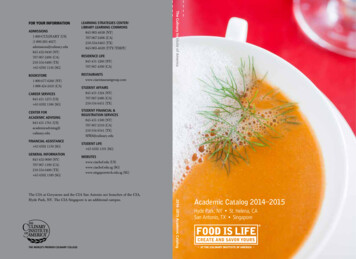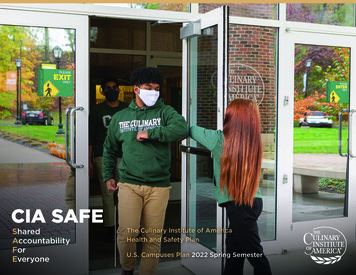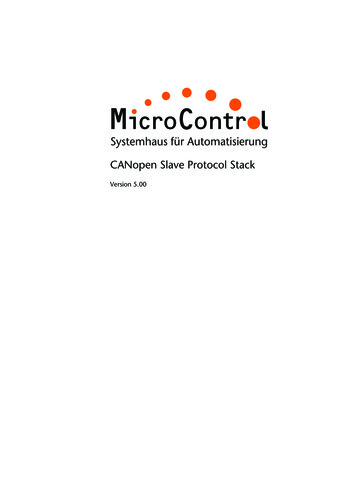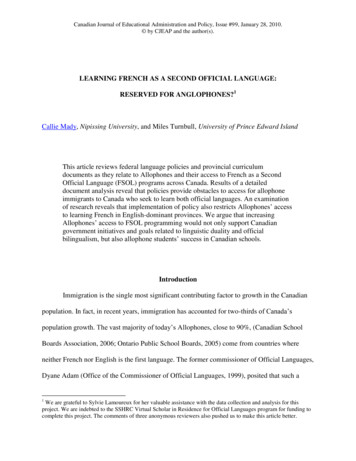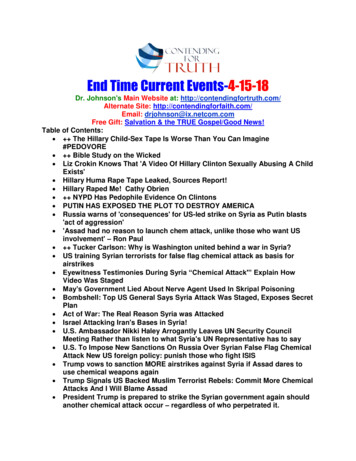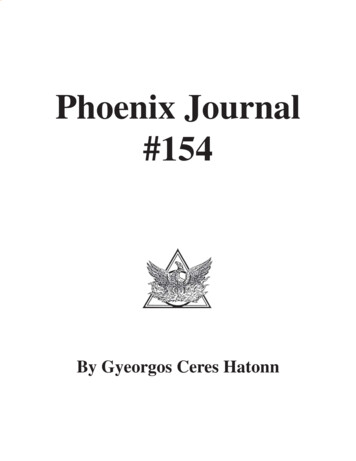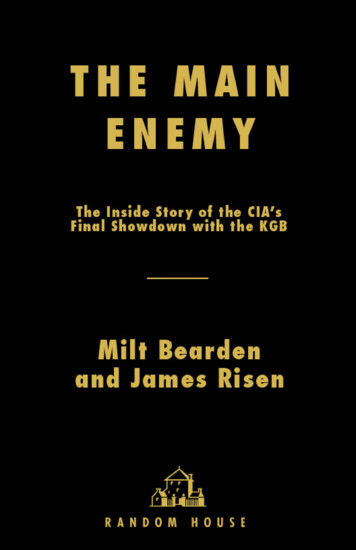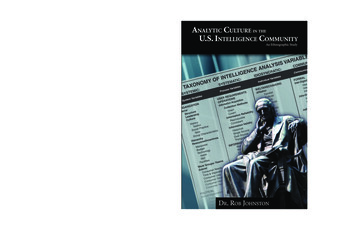
Transcription
The Official CIA Manual of Trickery and DeceptionH. Keith Melton and Robert Wallace
ContentsAcknowledgmentsForeword by John McLaughlinIntroduction: The Legacy of MKULTRA and the Missing Magic ManualsSome Operational Applications of The Art of DeceptionI. Introduction and General Comments on The Art of DeceptionII. Handling of TabletsIII. Handling of PowdersIV. Handling of LiquidsV. Surreptitious Removal of ObjectsVI. Special Aspects of Deception for WomenVII. Surreptitious Removal of Objects by WomenVIII. Working as a TeamRecognition SignalsNotes
Selected BibliographyAbout the AuthorsOther Books by H. Keith Melton and Robert WallaceCreditsCopyrightAbout the Publisher
ACKNOWLEDGMENTSIt is unlikely that either John Mulholland or Dr. Sidney Gottlieb, the CIA officer whoauthorized the creation of “Some Operational Applications of the Art of Deception” and“Recognition Signals,” ever anticipated their manuals would become available to anyonewithout security clearances. Both men understood that their respective professions, asmagician or CIA officer, required oaths of secrecy.The magician’s oath states:As a magician I promise never to reveal the secret of any illusion to a nonmagician, unless that one swears to uphold the Magician’s Oath in turn. Ipromise never to perform any illusion for any non-magician without firstpracticing the effect until I can perform it well enough to maintain the illusionof magic.Members of the magic community disavow anyone seen as betraying this oath, butalso recognize the necessity to expose secrets of their craft responsibly to students andothers desirous of learning magic. In his 2003 book, Hiding the Elephant: HowMagicians Invented the Impossible and Learned to Disappear, illusionist and author JimSteinmeyer addressed the conundrum faced by those seeking to write about magic, yetstill preserve its mysteries:In order to understand how Houdini hid his elephant, we’re going to have toexplain a few secrets. We’ll have to violate that sacred magician’s oath. In theprocess, I promise that there will be a few disappointments and more than a fewastonishments. But to appreciate magic as an art, you’ll have to understand notonly the baldest deceptions, but also the subtlest techniques. You’ll have to learnto think like a magician.In his popular general market book of 1963, Mulholland on Magic, the skilledpractitioner himself revealed many of the principles of magic that a decade earlier hadbeen included in his operational manuscript for the CIA. The real secret that Gottlieb andMulholland sought to preserve, however, was not of specific tricks, but that professionalintelligence officers, not just performing magicians, would be acquiring the necessaryknowledge to apply the craft to the world of espionage.
In a sense, this book is the result of two historical accidents. The first “accident” isthat of the thousands of pages of research conducted under the CIA’s decade-longMKULTRA program, to our knowledge, only two major research studies—Mulholland’smanuals—survived CIA Director Richard Helm’s order in 1973 to destroy all MKULTRAdocuments. Mulholland’s manuals are a rare piece of historical evidence that the CIA, inthe 1950s, through MKULTRA, sought to understand and acquire unorthodox capabilitiesfor potential use against the Soviet adversary and the worldwide Communist threat. Themanuals and other declassified MKULTRA administrative materials further reveal thatmany of America’s leading scientists and private institutions willingly participated insecret programs they agreed were critical to the nation’s security.The second “accident” was the authors’ discovery of the long-lost CIA manuals whileconducting unrelated research in 2007. Although portions of the manuals had beenpreviously described, referenced, or printed in part, we were unaware of the existence of acopy of the complete declassified work along with the original drawings and illustrations.Notable public references to the Mulholland manuals were made by magicianhistorian Michael Edwards in a 2001 article, “The Sphinx & the Spy: The ClandestineWorld of John Mulholland,” in Genii: The Conjurors’ Magazine, April 2001, a partialreproduction of Mulholland’s first manual in Genii, vol. 66 no. 8, August 2003, and BenRobinson’s MagiCIAn: John Mulholland’s Secret Life, Lybrary.com, 2008. Neither theCIA’s library, nor its Historical Intelligence Collection, contained a copy of Mulholland’smanuals.When retrieved by the authors, the manuals’ text was legible, but the poor quality ofphotocopied pages of Mulholland’s accompanying illustrations, drawings, andphotographs required careful study to understand his original intent. To enhance themanuals’ readability, corrections to grammar, punctuation, and related errors that do notalter the substance of the original material have been made. We are indebted to ourHarperCollins editor, Stephanie Meyers, for recommending Phil Franke as the illustrator,who has re-created the style and precision of the original images. The reader will findPhil’s mastery of capturing human hand and arm movements, which are central toMulholland’s explanation of his tricks, to be superb art.From the first day we mentioned this project, Daniel Mandel, our agent at Sanford J.Greenburger and Associates, was an enthusiastic promoter. We are deeply appreciativefor the personal interest in the subject by Steve Ross, then at HarperCollins, and his
actions in making the project possible. Stephanie Meyers provided excellent suggestionsand guidance in constructing the overall work and seeing it through to publication. TheHarperCollins graphic design team has created a distinctive cover that reflects thehistorical look and significance of the material.While researching, writing, and rewriting the book, we received the daily goodspirited assistance of Mary Margaret Wallace in typing and editing drafts that bouncedback and forth between the authors. Consistent encouragement and well-placedsuggestions and criticisms from Hayden Peake and Peter Earnest substantially improvedour initial drafts. Tony and Jonna Mendez offered perspectives from their experiencesthat enabled us to translate many of the elements of magic from theory to practice.Additional appreciation is owed to Jerry Richards, Dan Mulvenna, Nigel West, MichaelHasco, David Kahn, and Brian Latell, as well as Ben, Bill, and Paul for their insights andcontributions. Susan Rowen served as our “hand model” and kept our spirits roused asthe authors re-created each of Mulholland’s original photographs as references for artistPhil Franke.John McLaughlin, former deputy director and acting director of the CIA, reviewedthe manuscript to validate our use of magic terminology, as well as contributing thebook’s preface and administering the “magician’s oath” to the authors. John is anaccomplished amateur magician and, by virtue of his distinguished career at the CIA, isuniquely qualified to understand the rich overlap between the tradecraft of theintelligence officer and the magician. As a senior research fellow and lecturer at PhilipMerrill Center for Strategic Studies at the Paul H. Nitze School of Advanced InternationalStudies in Washington, D.C., he often begins presentations on strategic deception withdemonstrations from his repertoire of magic tricks.
FOREWORDby John McLaughlinFormer Deputy Director, Central IntelligenceThis is a book about an extraordinary American magician and the way his life intersectedwith American intelligence at a pivotal moment in its early history.John Mulholland was never a household word, like the world famous escapologistHoudini or, more recently, the illusionist David Copperfield. But among professionalmagicians from the 1930s to the 1950s, he was seen as the very model of what a magicianshould be—urbane, highly skilled, inventive, and prolific. He was very successfulprofessionally, entertaining mostly in New York City society circles. He published widelyon magic, both for the general public and for the inner circle of magicians who subscribedto the professional journal he edited for decades, The Sphinx. His impact on the art ofmagic was enormous.Mulholland’s 1932 book, Quicker Than the Eye, was one of the first books I stumbledon as a magic-struck boy combing the public library in the 1950s. I fondly rememberbeing transported by an author who seemed to have traveled the world and witnessedmarvelous things I could only imagine.That’s what fascinated me about Mulholland then. As a lifelong amateur magicianwho spent a career in American intelligence, what fascinates me about Mulholland todayis the way the story told here resonates with something I came to conclude in the courseof my professional life: that magic and espionage are really kindred arts.The manual that Mulholland wrote for the Central Intelligence Agency and that isreproduced here sought to apply to some aspects of espionage the techniques of stealthand misdirection used by the professional conjuror.Many may ask what these two fields have to do with each other. But a cursory look atwhat intelligence officers do illustrates the convergence.Just as a magician’s methods must elude detection in front of a closely attentiveaudience, so an intelligence officer doing espionage work must elude close surveillanceand pass messages and materiel without detection.
In another part of the profession, analysts must be as familiar as magicians withmethods of deception, because analysts are almost always working with incompleteinformation and in circumstances where an adversary is seeking to mislead them—or inthe magician’s term, misdirect them.Counterintelligence officers—people who specialize in catching spies—work in a partof the profession so labyrinthine that it is often referred to as a “wilderness of mirrors”—aphrase, of course, with magical overtones.Finally, there are the covert-action specialists. In any intelligence service, these arethe officers who seek at the direction of their national leaders to affect events orperceptions overseas, especially during wartime. Principles of misdirection familiar tomagicians were evident in many of the great British covert operations of World War II—such as deceiving Hitler into thinking the 1943 Allied invasion from North Africa wouldtarget Greece rather than its true target, Sicily. This was the conjuror’s stage managementapplied to a continent-sized theater.The manual Mulholland produced for the CIA does not read the way a book forexperienced magicians would read. He is clearly addressing an amateur audience andtakes care to explain things in the simplest of terms. Yet he draws on the underlyingprinciples of magic to explain how intelligence officers could avoid detection in the midstof various clandestine acts.A case can be made that Mulholland’s instruction influenced the more mundaneaspects of espionage tradecraft—how to surreptitiously acquire and conceal variousmaterials, for example. As best we know, however, the methods he designed for moreaggressive actions—clandestinely delivering pills and powders into an adversary’s drink,for example—were never actually used.The fact that he was asked to contemplate such things is emblematic of a uniquemoment in American history. American leaders during the early Cold War felt the nationexistentially threatened by an adversary who appeared to have no scruples. Mulholland’swriting on delivery of pills, potions, and powders was just one example of research carriedout back then in fields as diverse as brainwashing and paranormal psychology. Many suchefforts that seem bizarre today are understandable only in the context of those times—theformative years of the Cold War.
These were also the formative years for the American intelligence community. It isimportant to remember that this was a very new field for the United States. Most othercountries had long before integrated espionage into the national security tool kit; theChinese strategist Sun Tsu had written about it in sophisticated terms in the sixth centuryB.C. , and older countries such as Britain, Russia, and France had been at it for centuries.While the United States had used intelligence episodically, it was not organized at anational-level effort until 1947, and our young country struggles still today with its properplace in our national security strategy.I doubt many intelligence officers today would recognize John Mulholland’s name.But the essence of his contribution had little to do with notoriety or fame. It was, ineffect, to help the nation’s early intelligence officers think like magicians. Given the closekinship between these two ancient arts, that was a significant contribution indeed andone that continues—in stealthy ways that Mulholland would probably admire—to thisvery day.
INTRODUCTION: The Legacy of MKULTRA and the Missing Magic ManualsMagic and Intelligence are really kindred arts.-JOHN MCLAUGHLIN,FORMER DEPUTY DIRECTOR OF CENTRAL INTELLIGENCEIn 2007, the authors discovered a long-lost CIA file, once classified top secret, whichrevealed extraordinary details of the agency’s connection to the world of magic decadesearlier. The documents, part of project MKULTRA, shed light on a fascinating and littleknown operation—the employment of John Mulholland as the CIA’s first magician. Anaccomplished author and America’s most respected conjurer of his day, Mulhollandauthored two illustrated manuals for teaching CIA field officers how to integrateelements of the magician’s craft into clandestine operations. Due, in part, to theextraordinary levels of secrecy surrounding MKULTRA, the manuals were considered toosensitive to be distributed widely and all copies were believed to have been destroyed in1973.1 Nearly fifty years after they were written, rumors of the existence of a long-lostcopy of the “magic” manuals continued to fly through the corridors at Langley, but manyintelligence officers thought they were a myth.2 To understand the CIA’s first magician,and how his remarkable manuals came to be, it is necessary to recall one of the mostdangerous periods in U.S. history.With its establishment in July 1947, the CIA received two primary missions—preventsurprise foreign attacks against the United States and counter the advance of Sovietcommunism into Europe and third-world nations. Officers of “the Agency,” as the CIAbecame known, would be on the front lines of the Cold War for four tense decades fueledby nuclear stalemate, incompatible ideologies, and a Soviet government obsessed withsecrecy. At home, the USSR’s security and intelligence organizations, the KGB and itspredecessors, cowed the internal population, and abroad they attempted to undermineforeign governments aligned with the West.The Soviet Union’s successful testing of a nuclear weapon in 1949 caught the UnitedStates by surprise and created two nuclear powers competing in an internationalatmosphere of fear and uncertainty. President Eisenhower received a startling top secretreport in 1954 from a commission headed by retired general James H. Doolittle thatconcluded, “If the U.S. is to survive, long-standing American concepts of ‘fair play’ must
be reconsidered. We must learn to subvert, sabotage, and destroy our enemies by cleverer,more sophisticated, and more effective methods than those used against us. It maybecome necessary that the American people become acquainted with, understand, andsupport this fundamentally repugnant philosophy.”3The report affirmed a threat to the Western democracies from Soviet-sponsoredaggression and called for an American offensive and defensive intelligence posture unlikeanything previously authorized in peacetime. As a result, the CIA’s covert-action roleexpanded from Europe into the Middle East, Africa, Latin America, and the Far East.Reflecting on those years more than half a century later, former U.S. secretary of stateHenry Kissinger asserted that during the decade of the 1950s only the United States stoodbetween Soviet-led communism and world freedom.4The CIA had been engaged in covert programs since its creation and in 1951 formed aspecial unit, the Technical Services Staff (TSS), to exploit advances in U.S. technology insupport of espionage operations. One of TSS’s first employees was Dr. Sidney Gottlieb,whose degree in chemistry from the California Institute of Technology made him a logicalchoice to head the handful of chemists in the staff. Initially the chemistry branch createdand tested formulas, or “special inks,” for secret writing that enabled CIA spies to embedinvisible messages in otherwise innocuous correspondence.5 To conceal the liquid“disappearing inks,” TSS reformulated the liquids into a solid form that looked likeaspirin tablets and repackaged the tablets in pill bottles that would pass unnoticed in anagent’s medicine cabinet. When a spy had information to convey, he would dissolve thetablet in water or alcohol to reconstitute the ink for his secret message.TSS supported other activities of the Agency as well: forging travel and identitydocuments for agents who worked under alias names, printing propaganda leaflets,installing clandestine microphones and cameras, and building concealments for spyequipment in furniture, briefcases, and clothing. To those uninitiated in the craft ofespionage, the secretive work of the TSS scientists and engineers at times appeared toaccomplish the impossible. In reality, this handful of CIA scientists was demonstratingthe third law of prediction advanced by science-fiction author Arthur C. Clarke: “Anysufficiently advanced technology is indistinguishable from magic.”6
Dr. Sidney Gottlieb, Chief, CIA Technical Services Division, 1966–1973.Phil FrankeDr. Gottlieb and his chemists expanded their research during 1953 to counteranother unanticipated Soviet threat. The three-year-long Korean War had stalemated andthe alliance of North Korea, China, and the Soviet Union seemed on the road to masteringthe art of “mind control.” Such a capability could render soldiers, and possibly entirepopulations, vulnerable to Communist propaganda and influence. Reports reached theCIA about Soviet clandestine successes with mind control and newly discoveredcapabilities to brainwash, recruit, and operate agents with the aid of drugs.7Mind control appeared to allow the Communists, using a combination ofpsychological techniques and newly developed pharmacological compounds, to remotelyalter a subject’s mental capacities and control his “free will.”8 Despite limited research onsimilar topics during World War II and the early 1950s, the science underlying thereported Soviet successes remained a mystery. America needed to understand thescientific basis of mind control and develop safeguards and, if necessary, applications forits own use.In March 1953, Allen Dulles, Director of Central Intelligence, entrusted the thirtyfour-year-old Gottlieb with one of America’s most secret and sensitive Cold Warprograms, code-named MKULTRA. Dulles authorized TSS and Dr. Gottlieb’s chemicalstaff to begin work on multiple projects for “research and development of chemical,biological, and radiological materials capable of employment in clandestine operations tocontrol human behavior.”9
MKULTRA eventually encompassed 149 subprojects and remained one of the CIA’smost carefully guarded secrets for over twenty years.10 Its projects aimed to understandhow drugs and alcohol altered human behavior and to protect American assets fromSoviet psychological or psychopharmaceutical manipulation. The research includedclandestine acquisition of drugs, clinical testing on and experimentation with humans,some of whom were unaware of said testing, and grant proposals and contracts withhospitals, companies, and individuals. The scientists investigated topics ranging fromconcocting truth serums to developing a humane way to incapacitate guard dogs using apowerful tranquilizer mixed into ground beef.11 Several projects involved research onlittle-understood mind-altering drugs such as LSD and marijuana. In the end, theresearch produced an assortment of potential offensive capabilities involvingincapacitating, lethal, and untraceable toxins.However, the absence of scientific data in the early 1950s about the effective and safedosage levels of the new drugs, including LSD, presented a problem for the MKULTRAresearchers. As a result, Gottlieb and members of his team performed experiments onthemselves that included ingesting drugs and observing and recording their ownreactions. In late 1953, an early LSD experiment involving several government scientistswent horribly bad.“Hush puppy” pills contained a harmless tranquilizer, which was mixed with ground beefand fed to the dog. To avoid suspicion, adrenaline-filled syrettes would reawaken the dogwhen the mission was concluded.Phil FrankeDr. Frank Olson was working at the U.S. Army Special Operations Division (SOD)
biological weapons facility at Ft. Detrick, Maryland, and assisting the CIA on MKULTRAprojects. Along with half a dozen other scientists, he volunteered to attend a retreatduring mid-November 1953 at the remote Deep Creek Lodge in western Maryland,organized by Gottlieb.12 Together with seven other researchers from TSS and Ft. Detrick,Olson was served Cointreau liqueur that had secretly been spiked with seventymicrograms of LSD. After thirty minutes, the participants were told of the LSD andalerted to begin studying their reactions. Most reported little effect, but Olson had a “badtrip” that night. As his condition worsened in the following days, Gottlieb’s deputy, Dr.Robert Lashbrook, escorted him to New York City for psychiatric counseling. Thisattention and treatment seemed to calm Olson temporarily, but later that evening onNovember 24, 1953, he jumped to his death from a tenth-floor window of his New Yorkhotel room.CIA executives, seeking to protect the secrecy of the MKULTRA program, did notfully reveal the circumstances of Olson’s death to his family. No other fatalities from theMKULTRA experiments occurred, but two decades passed before Olson’s widow receiveda delayed apology from President Gerald Ford and a financial settlement from the U.S.government.13Soviet intelligence in the 1950s, however, was less averse to death, either from accident orfrom assassination. Nikita Khrushchev, the successor to dictator Joseph Stalin, continuedthe existing policy of “special actions” as a central tool for dealing with the leaders of antiSoviet émigré groups.14 The first target of the post-Stalinist era, Ukrainian nationalistGeorgi Okolovich, was spared when the assassin, KGB officer Nikolai Khokhlov,confessed the plot to his victim and defected to the CIA. On April 20, 1954, Khokhlov gavea dramatic press conference and revealed both the assassination plot and his exoticweapon to the world.15 The execution device was an electrically operated gun and silencerhidden inside a cigarette pack that shot cyanide-tipped bullets.16 This failure wasfollowed soon thereafter by the successful assassinations of Ukrainian leaders Lev Rebetin 1957 and Stephen Bandera in 1959. Both were killed by KGB assassin BogdanStashinsky, who defected in 1961 and revealed that he had disposed of his weapon, acyanide gas gun concealed in a rolled-up newspaper, in a canal near Bandera’s residencein Munich, Germany.17 An analysis of the KGB cigarette-pack gun and Stashinsky’s
cyanide weapon, recovered from the canal, stimulated accelerated U.S. efforts to createcomparable weaponry for the United States.18The Nondiscernible Bioinoculator.Phil FrankeFrom the beginning of MKULTRA, CIA scientists researched lethal chemical andbiological substances, as well as “truth serums” and hallucinogens, as they continuedwork begun in the Office of Strategic Services during World War II. Under a joint projectcode-named MKNAOMI, TSS and the SOD cooperated on development of ingeniousweapons and exotic poisons. One Army-produced handgun, called the “nondiscerniblebioinoculator,” resembled a .45-caliber Colt pistol that, fitted with a telescopic sight anddetachable shoulder stock, fired a toxin-tipped dart silently and accurately up to 250 feet.The dart was so small—slightly wider than a human hair—it was nearly undetectable andleft no traces in the target’s body during an autopsy.19 Other dart-firing launchers weredeveloped and concealed inside fountain pens, walking canes, and umbrellas.20A toothpaste tube used as concealment for the CIA STINGER, a small .22-caliber singleshot firing device.Phil FrankeResearch was also conducted on a variety of exotic poisons including shellfish toxins,cobra venom, botulinium, and crocodile bile.21 Under the MKULTRA program, the CIAstockpiled eight different lethal substances and another twenty-seven temporaryincapacitates either for specific operations or as on-the-shelf capabilities for possiblefuture use.22 In one example, a tube of poison-laced toothpaste was prepared forinsertion into the toiletry kit of President Patrice Lumumba in 1960. However, the CIA
office chief in Leopoldville, Larry Devlin, rejected the plan and tossed the tube into thenearby river.23 About the same time, CIA treated a handkerchief with an incapacitatingagent, brucellosis, to be sent to a targeted Iraqi colonel, 24 but the man was shot by afiring squad before the handkerchief ever arrived.25Illustration of original vials of lethal shellfish toxin created for MKULTRA.Phil FrankePerhaps some of the most creative and almost whimsical CIA plots considered in theearly 1960s were part of Operation Mongoose, meant to discredit or assassinate Cubanleader Fidel Castro using an assortment of incapacitating and deadly paraphernalia.26The CIA considered modifying various devices for assassinating Castro.Phil FrankeHALLUCINOGENIC SPRAYS AND CIGARS: One bioorganic chemist proposedspraying LSD inside Castro’s broadcasting studio in Havana to cause him tohallucinate.27 Since Castro famously smoked cigars, another idea suggested impregnatingCastro’s cigars with a special chemical to produce temporary disorientation during hisrambling speeches during their live broadcast to the Cuban people.28
CONTAMINATED BOOTS: When Castro traveled abroad, he often left his bootsoutside the hotel room door at night to be shined. CIA considered dusting the insides ofthe boots with thallium salts, a strong depilatory, which would cause his beard to fall out.The chemical was procured and tested successfully on animals, but the plan scrappedwhen Castro canceled the targeted trip.29DEPILATORY, POISONED, AND EXPLODING CIGARS: Similar to thedusted-boot concept, Castro’s cigars could be treated with a powerful depilatory, causingloss of beard and corresponding damage to his “macho” image. A special box of cigars wasto be provided for Castro during an appearance on David Susskind’s television talk show.However, after a senior CIA officer questioned how the operation could ensure that onlyCastro would smoke the cigars, the idea was abandoned.30In another attempt, a Cuban double agent was recruited to offer Castro a cigartreated with botulin, a deadly toxin that would cause death within seconds. The cigarswere passed to the agent in February 1961, but he failed to carry out the plan.31 Cubansecurity officials eventually created a private cigar brand, the Cohiba, exclusively forCastro, to safeguard his supply against future assassination attempts.A third concept involved planting a box of exploding cigars at a place where Castrowould visit during a trip to the United Nations and “blow his head off.” The plan was notcarried out.32In addition to cigars, Castro enjoyed Cuba’s oceans and beaches, which offered anoperational venue for:EXPLODING SEASHELLS: TSD was asked in 1963 to construct a seashell filled withexplosives. This device was to be planted near Cuba’s Veradero Beach, a place whereCastro commonly went skin diving. CIA discarded the idea as impractical when it failed anoperational review.33CONTAMINATED DIVING SUIT: A proposal was made for an intermediary topresent Castro with a diving suit and breathing apparatus contaminated with tubercle
bacillus (tuberculosis germ).34 CIA obtained a diving suit and dusted it to produceMadura foot, a chronic skin disease. The plan failed when the intermediary chose topresent a different diving suit.35POISONED PEN: About the same time that President Kennedy was assassinated inDallas—November 22, 1963—a CIA officer met secretly with Rolando Cubela, a Cubanagent in Paris, and offered a poisoned pen to kill Castro. The device, a Paper Mateballpoint, was modified to conceal a small hypodermic syringe for injecting Blackleaf-40poison. Even the slightest prick would result in a certain death, though the agent wouldhave time to escape before the effects were noticed. After learning of Kennedy’s death,however, Cubela reconsidered the plan and disposed of the pen prior to returning toCuba.36 A decade later, in 1976, American policy governing lethal actions against foreignleaders was formalized when President Ford issued Executive Order 11905 prohibitingpolitical assassinations.37A hypodermic syringe was concealed inside this modified Paper Mate pen for an operationto assassinate Castro.Phil FrankeFrom the earliest days of MKULTRA, Dr. Sidney Gottlieb recognized that CIA’s drugsand chemicals, regardless of their ultimate purpose, would be operationally uselessunless field officers and agents could covertly administer them. During the same monthMKULTRA was authorized, April 1953, Gottlieb contacted John Mulholland, then fiftyfive years old and one of America’s most respected magicians. Mulholland was an expertin sleight of hand or “close-up” magic, a style of conjuring that appealed to Gottliebbecause it was performed only a few feet from the audience.38 Further, sleight-of-hand
illusions required no elaborate props for support. If Mulholland could deceive asuspecting audience who was studying his every
book’s preface and administering the “magician’s oath” to the authors. John is an accomplished amateur magician and, by virtue of his distinguished career at the CIA, is uniquely qualified to understand the rich overlap between the tradecraft of the intelligence officer and the mag

